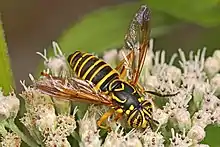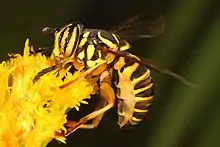Spilomyia longicornis
Spilomyia longicornis is a species of syrphid fly, also known as a flower fly or hoverfly, in the family Syrphidae. Although the appearance of S. longicornis is remarkably similar to a vespid wasp, it is a fly and cannot sting.[1] It occurs in North America, east of the Rocky Mountains.[2]

| Spilomyia longicornis | |
|---|---|
 | |
| Scientific classification | |
| Kingdom: | Animalia |
| Phylum: | Arthropoda |
| Class: | Insecta |
| Order: | Diptera |
| Family: | Syrphidae |
| Genus: | Spilomyia |
| Species: | S. longicornis |
| Binomial name | |
| Spilomyia longicornis Loew, 1872 | |
| Synonyms | |
| |
Description
S. longicornis is typically 11-15 millimeters long.[3] S. longicornis has a black body with yellow markings and stripes on its abdomen.[4] Its wings are mostly clear with a dark tinge, and the anterior portion of the wings are typically darker brown in color.[4] The back four legs are yellowish in color, and the front two legs are yellow at the base and black at the ends.[4] They tend to rest on their back four legs and move their front two legs above their head, making them appear like antennae on the Hymenoptera species that they mimic.[4]

Taxonomy
S. longicornis flies are part of the Syrphidae family, which is of the order Diptera. The hoverfly family is one of the most diverse in the Diptera order.[5] There are at least 200 genera and 5000 species included in this family.[5]
Distribution and habitat
S. longicornis is widespread in eastern North America.[2] These flies can be found near and around flowers that produce pollen and nectar, which they feed on.[6] Also, rotting trees are an important environmental component of their habitat.[7] S. longicornis larvae are typically found in rot holes, or rotting cavities found in live trees, and develop there.[8] Almost all types of trees can develop rot holes, but they are more common for certain types of trees than others.[8] The rot holes provide a food source and protection for the larvae.[8] Thus, these damp environments are ideal for larval development.[8] Adult S. longicornis flies are most often found hovering over flowers that produce large amounts of pollen and nectar, the adults' food source.[6]
Life History
S. longicornis larvae are found in rot holes in rotting trees.,[8] while adults spend the majority of their time around flowers to get pollen and nectar for food and for mating.[6] Females need pollen for reproductive development.[6]
Only adult S. longicornis flies eat the pollen and nectar from flowers.[6] Pollen has a high content of nitrogenous nutrients. Because of this, females are able to use the nutrients from pollen to develop their reproductive tissues.[6] These nutrients, which are not consumed by S. longicornis flies until adulthood, are important for vitellogenesis, also known as yolk deposition.[6] They also consume nectar from flowers and use that energy for their hovering behavior.[6]
Mating
S. longicornis males have been directly observed mate-seeking near flowers.[7]
Mimicry
Most Syrphidae flies mimic Hymenoptera species.[9] S. longicornis mimics vespid species including introduced species such as Vespula vulgaris.[1] S. longicornis flies mimic vespid wasps in three main ways: physically, behaviorally, and auditorily. Just like vespid wasps, the anterior portion of the wings of S. longicornis flies are a darker brown color than the rest of the wing.[4] Their abdomen is yellow with black stripes, and the thorax and head are similarly colored.[4] Behaviorally, S. longicornis flies mimic the way common wasps move their antennae.[4] By resting on their back four legs and placing and moving their two front black legs above their head, they more closely resemble wasps.[10] When threatened, S. longicornis bend their abdomen in a similar fashion to wasps who are stinging a predator.[4] They may also move their abdomen up and down when they are on a flower, which is a mimic of wasp abdomen expansion.[4] Finally, it has been documented that S. longicornis flies, when threatened, produce a different buzzing sound than normal.[11] While wasps do not necessarily produce a different sound upon attack, the sound S. longicornis makes when threatened seems to be of a frequency similar to some hymenopteran species.[11] This strategy may have evolved because the visual and behavioral mimicry may not always work.[11]
External links
- Diptera.info
- NCBI Taxonomy Browser, Spilomyia longicornis
 Media related to Spilomyia longicornis at Wikimedia Commons
Media related to Spilomyia longicornis at Wikimedia Commons
References
- Penney, H. (2001). Evolution of Imperfect Mimicry: Explaining Variation in Mimetic Fidelity among Syrphid Species. Ottawa, ON: Carleton University. https://curve.carleton.ca/system/files/etd/c3df345b-38ec-4006-8143-6698a6294f9d/etd_pdf/d4161934a9585fb98190d9a19bed4e1b/penney-evolutionofimperfectmimicryexplainingvariation.pdf
- Spilomyia longicornis Loew, 1872. (n.d.). Retrieved October 27, 2019, from Discover Life website: https://www.discoverlife.org/mp/20q?search=Spilomyia+longicornis
- Species Spilomyia longicornis. (n.d.). Retrieved October 23, 2019, from Bug Guide website: https://bugguide.net/node/view/5906
- Curran, C. H. (1951). Synopsis of the North American species of Spilomyia (Syrphidae, Diptera). American Museum Novitates. http://digitallibrary.amnh.org/bitstream/handle/2246/2364//v2/dspace/ingest/pdfSource/nov/N1492.pdf?sequence=1&isAllowed=y.
- Katzourakis, A. , Purvis, A. , Azmeh, S. , Rotheray, G. and Gilbert, F. (2001), Macroevolution of hoverflies (Diptera: Syrphidae): the effect of using higher‐level taxa in studies of biodiversity, and correlates of species richness. Journal of Evolutionary Biology, 14: 219-227. doi:10.1046/j.1420-9101.2001.00278.x
- Branquart, E., & Hemptinne, J.-L. (2000). Selectivity in the exploitation of floral resources by hoverflies (Diptera: Syrphinae). Ecography, 23, 732-742. Retrieved from https://onlinelibrary.wiley.com/doi/epdf/10.1111/j.1600-0587.2000.tb00316.x
- C.T. Maier, G.P. Waldbauer (1979) Dual mate-seeking strategies in male syrphid flies (Diptera: Syrphidae). Annals of the Entomological Society of America 72: 54–61 https://doi.org/10.1093/aesa/72.1.54
- Sommaggio, D. (1999). Syrphidae: can they be used as environmental bioindicators? Agriculture, Ecosystems & Environment, 74(1-3), 343-356. https://doi.org/10.1016/S0167-8809(99)00042-0
- Waldbauer, G. P. (n.d.). Mimicry of Hymenopteran Antennae by Syrphidae. Department of Entomology, University of Illinois.
- Rashed, A., & Sherratt, T. N. (2006). Mimicry in hoverflies (Diptera: Syrphidae): a field test of the competitive mimicry hypothesis. Behavioral Ecology, 18(2), 337–344. https://doi.org/10.1093/beheco/arl089
- A. Rashed, M.I. Khan, J.W. Dawson, J.E. Yack, T.N. Sherratt, Do hoverflies (Diptera: Syrphidae) sound like the Hymenoptera they morphologically resemble?, Behavioral Ecology, Volume 20, Issue 2, March–April 2009, Pages 396–402, https://doi.org/10.1093/beheco/arn148